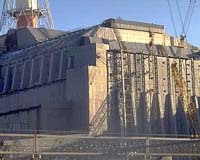 |
Rikuzentakata, Japan (AFP) April 2, 2011 Japan's premier on Saturday visited emergency crew who have struggled to stabilise a tsunami-hit nuclear plant that has leaked radiation into the air, ground and ocean. The visit came as the firm operating the Fukushima power station announced it had discovered a crack in a pit leaking highly radioactive water straight into the sea. Donning a blue workman's outfit, Prime Minister Naoto Kan arrived by military helicopter to give a pep talk to the atomic plant workers, firefighters and troops battling to shut down the plant. "I want you to fight with the conviction that you absolutely cannot lose this battle," Kan told them at their base, the J-Village football academy 20 kilometres (12 miles) from the plant, Kyodo News reported. He urged military personnel there to "fight to determine Japan's fate". The hundreds of workers and troops have battled to stabilise the plant since the tsunami three weeks ago knocked out its water cooling system, leading fuel rods to overheat, partially melt down and release radioactivity. The crew have endured gruelling conditions and the threat of high radiation. The government has hiked the exposure limit for emergency workers from 100 to 250 millisieverts, the equivalent of 10 brain scans. The workers have used fire engines and concrete pumps to pour thousands of tons of water into overheating reactors and spent fuel rod pools, creating clouds of radioactive steam and highly contaminated runoff. The nuclear safety agency said a 20-centimetre (eight-inch) crack had been found in a concrete pit from where water has leaked into the sea, where iodine-131 over 4,000 times the legal limit has been measured. Plant operator Tokyo Electric Power Company (TEPCO) said workers would cement over the crack. In longer term efforts to control the emergency, two of the world's largest cement boom pumps with a 70-metre reach were to be shipped to Japan from the United States, supporting models already sent by Germany and China. The truck mounted pumps -- similar to those used to seal off Ukraine's Chernobyl plant after its 1986 meltdown -- can be remote-controlled and shoot either water or, if necessary, cement to entomb the facility. TEPCO "didn't specifically say that they wanted to pump concrete, but it is the option. They don't have to bring in more equipment should that need occur," said Kelly Blickle of the US subsidiary of German pump maker Putzmeister. The two pumps are scheduled to fly to Japan on April 9 aboard Russian Antonov AN-225 transport planes, the world's largest aircraft. Japan also planned to deploy a floating steel pontoon that can hold 18,000 tonnes of water, to safely store the highly radioactive runoff that has accumulated in turbine room basements and tunnels, media reports said. As Fukushima has belched radiation that has been measured in minuscule traces as far as New York, Japan has imposed a 20-kilometre exclusion zone around it and has urged people within 30 kilometres to move away. "I can't tell you how bitter I feel," said one evacuee, a retired Fukushima plant worker who now lives in a school sports hall with more than 1,300 other people in Kazo city, Saitama prefecture, near Tokyo. "I still don't know how I should look at all of this," said the man, who declined to give his name. "I had never dreamed of such an accident." In Tokyo, Japan's foreign minister promised a full investigation. "Japan will thoroughly examine the accident and wants to contribute to the international community by doing so," said Takeaki Matsumoto after meeting his German counterpart, who called for international nuclear safety standards. Beyond those displaced by the nuclear crisis, tens of thousands of people lost their homes in the massive quake and tsunami that by the latest count left 11,800 dead and 15,540 missing. A massive US-Japanese military search for bodies -- with 25,000 personnel on helicopters, planes, ships and on the ground -- went into its second day, recovering 57 bodies on Saturday. On Friday, they found 110 bodies on the coastlines and inland. The search focused on badly hit Ishinomaki in Miyagi prefecture. Rescuers scoured an elementary school where many children went missing and 50 divers were deployed to the nearby Kitakami River, Kyodo News reported. Kan earlier Saturday for the first time set foot in the tsunami zone, visiting the devastated port of Rikuzentakata, a muddy wasteland of concrete ruins, with a lone pine tree left from what used to be a forest. He visited evacuation centres in the town where more than 1,000 people died and over 1,200 are missing. One of the newly homeless, Michie Sugawara, said she welcomed Kan but voiced fears about the future. "There will be a long road ahead," the 44-year-old told AFP. "This is an unprecedented disaster. I wish he will not forget about us."
Share This Article With Planet Earth
Related Links Bringing Order To A World Of Disasters A world of storm and tempest When the Earth Quakes
 Fukushima 'much bigger than Chernobyl': expert
Fukushima 'much bigger than Chernobyl': expertWashington (AFP) April 1, 2011 Japan's unfolding nuclear disaster is "much bigger than Chernobyl" and could rewrite the international scale used to measure the severity of atomic accidents, a Russian expert said here Friday. "Chernobyl was a dirty bomb explosion. The next dirty bomb is Fukushima and it will cost much more" in economic and human terms, said Natalia Mironova, a thermodynamic engineer who became a leading an ... read more |
|
| The content herein, unless otherwise known to be public domain, are Copyright 1995-2010 - SpaceDaily. AFP and UPI Wire Stories are copyright Agence France-Presse and United Press International. ESA Portal Reports are copyright European Space Agency. All NASA sourced material is public domain. Additional copyrights may apply in whole or part to other bona fide parties. Advertising does not imply endorsement,agreement or approval of any opinions, statements or information provided by SpaceDaily on any Web page published or hosted by SpaceDaily. Privacy Statement |